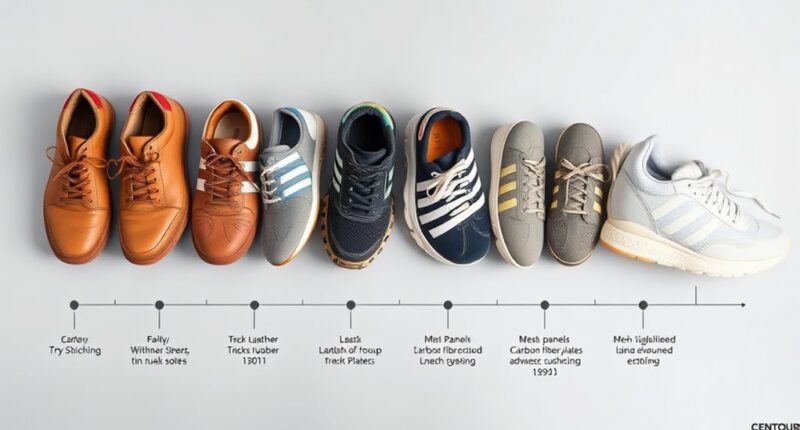Over the past century, track shoes have transformed from simple leather soles to high-tech gear designed for performance. Advances include rubber soles, lightweight synthetic uppers, carbon fiber plates, and breathable mesh to enhance speed, support, and comfort. Innovations continually push athletic limits, making shoes lighter and more efficient. If you continue exploring, you’ll discover the fascinating milestones that shaped today’s cutting-edge running equipment.
Key Takeaways
- Early 20th century innovations introduced rubber soles, foam insoles, and lightweight designs to improve athletic performance.
- Post-war era focused on comfort, proper fit, and specialized track shoes with replaceable spikes for different surfaces.
- The 1960s-70s saw the rise of carbon fiber plates and synthetic uppers, making shoes lighter and more supportive.
- Modern track shoes feature breathable materials, foam cushioning, and engineered support tailored to specific events.
- Continuous technological advancements have driven the evolution from handcrafted leather to high-tech, performance-optimized footwear.
Evolution of Track Shoe Technology

During the 1920s and 1930s, shoe manufacturing became more sophisticated, driven by advancements in rubber and new sole designs. Athletes needed lighter, more responsive shoes, prompting manufacturers to introduce rubber soles that improved grip and shock absorption. The athletic footwear evolution accelerated in the post-war years, with innovations like vulcanized rubber and the introduction of foam insoles making shoes more comfortable and functional. These improvements helped athletes run faster and jump higher, setting new records and pushing the limits of human performance. Additionally, the importance of proper shoe fit became increasingly recognized to prevent injuries and enhance performance. The 1960s and 1970s saw the emergence of specialized track shoes tailored for different events. Manufacturers began designing spikes and plates that could be removed or replaced for specific track surfaces and distances. During this period, technological advancements like carbon fiber plates and lightweight synthetic uppers revolutionized shoe manufacturing, making shoes lighter without sacrificing support. This era marked a significant leap in athletic footwear evolution, giving athletes an edge over their competitors. In the late 20th century and into the 21st, the focus shifted towards optimizing energy return and reducing weight. Modern track shoes incorporate advanced materials such as breathable mesh uppers, carbon fiber plates, and foam cushioning that absorbs impact while propelling you forward. These innovations are made possible through the use of advanced materials, which have further enhanced shoe performance and durability. Shoe manufacturing now involves precise engineering and computer-aided design, allowing brands to create shoes that perfectly balance support, flexibility, and weight. This technological progression is a direct result of decades of research into athletic footwear evolution, driven by a desire to push performance boundaries. Today, you benefit from decades of innovation, with track shoes that are lighter, more responsive, and better suited to your specific needs. From the handcrafted leather designs of the early 1900s to today’s high-tech marvels, the evolution of athletic footwear has been a relentless pursuit of improvement. Every stride you take on the track is supported by a century’s worth of advancements in shoe manufacturing, helping you run faster, feel more confident, and reach your full potential.
Frequently Asked Questions
How Have Track Shoe Designs Impacted Athlete Performance Over the Decades?
You’ve seen how track shoe designs have evolved, especially with sprint shoe evolution and marathon performance gear. These improvements boost your performance by reducing weight, increasing grip, and enhancing comfort. Modern materials and innovative features help you run faster and longer, giving you a competitive edge. As designs progress, you’ll notice better energy return and support, making it easier to push your limits and achieve your athletic goals.
What Materials Were Used in Early Track Shoes Compared to Modern Ones?
You’ll find that early track shoes mainly used ancient materials like leather and simple rubber, which offered limited flexibility and durability. Today, modern composites such as lightweight synthetic fabrics, high-tech foams, and advanced rubber compounds are standard, making shoes more comfortable, supportive, and efficient. These innovations help boost your performance by reducing weight and increasing responsiveness, showing how material advancements have evolved considerably since the early days of track footwear.
How Have Track Shoe Manufacturing Processes Evolved Over 100 Years?
Imagine the evolution of track shoe manufacturing as a masterpiece painted with innovation. Over the last century, you’ve seen a shift from labor-intensive, manual processes to automated, high-tech methods. Historical manufacturing now blends precision with speed, enabling shoe customization to fit each athlete perfectly. You benefit from advanced materials and streamlined production, ensuring your gear is lighter, stronger, and tailored to enhance your performance on the track.
What Role Did Technological Innovations Play in Injury Prevention?
You benefit from technological innovations like innovative cushioning and biomechanical advancements that play a vital role in injury prevention. These developments improve shock absorption, support proper gait, and reduce stress on your joints. By integrating such features into modern track shoes, manufacturers help you stay protected during intense training and races, ultimately lowering your risk of injuries and enhancing your athletic performance.
How Do Different Track Surfaces Influence the Design of Track Shoes?
Imagine you’re designing track shoes in the age of hoverboards—futuristic, right? Different surfaces, like synthetic tracks or natural grass, demand specific shoe features. You focus on improving running grip and surface compatibility, ensuring your shoes perform well on each terrain. The shoe design adapts with sole patterns, cushioning, and materials, so you stay safe and efficient, regardless of whether you’re racing on a smooth track or rugged trail.
Conclusion
So, after a century of innovation, your sleek, high-tech track shoes might seem like magic. Yet, all it took was a century of trial, error, and clever engineering to get here. Ironically, despite all the advancements, sometimes a simple pair of shoes is still your best bet. Who knew that behind those cutting-edge designs lies centuries of sweat and setbacks? Next time you lace up, remember—you’re walking in a legacy of stubborn progress.









